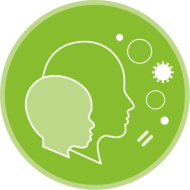Frank: Air pollution is definitely a global problem. We now have statistics coming from the World Health Organization that up to 8 million people are dying prematurely across the globe because of the quality of air they’re breathing.
Marcella: Children are amongst the groups in the population that are most vulnerable to pollution. One of the things to consider is that children obviously are still developing, their organs are still developing, and that can make them more susceptible to a number of risk factors including air pollution.
Marcella: Some of the effects of air pollution can be long-lasting in affecting them throughout the life course.
Ian: There are short-term and long-term effects. The short-term effects are like the exacerbation of asthma, for example. The long-term effects – actually that’s where most of the burden of air pollution’s impacts are felt. You’re often told it’s linked to premature death; but what does that really mean? It means people are dying earlier of cardiovascular disease, respiratory disease. It’s not just they are losing maybe weeks or months off the end of their life; they’re experiencing poor health for a much longer period of time. That, I think, is a critical message to get across.
Douglas: We’ve always been exposed to dust, fires and smoke but have evolved to live in those types of environments. But the industrial pollution, the combustion particles we see from automobiles and power plants and so forth has put an extra burden on us that we have to deal with.
Frank: We’ve had a lot of work done since the mid-90s on ambient pollution – outdoor pollution. What we don’t have is much understanding of these indoor environments. We’re spending 90 percent of our time indoors so that environment is potentially having a much bigger effect on our health than it would have done in previous generations.
Alex: Most people, when they get home, they shut their front door, when they get inside, they think they’re in a sort of safe haven; and actually it’s quite the opposite potentially. Because the outdoor air pollution problems actually migrate indoors so you see the same pollutants going into a home. And then there’s the pollution events that you actually generate yourself when you’re at home.
Frank: We start off with individual pollutants being released; maybe from candle burning, wood stove release, through cleaning products, through our carpets, through our furniture which are now all covered in fire retardant chemicals. When we fry, we release a lot of particles and gases. They will interact, invisibly all around us and we will get secondary reactions. And we will get new pollutants being produced; some of which we know about, some of which we don’t know about yet probably. And then we’re breathing in this cocktail.
Marcella: When people are outdoors, they can be exposed to elevated peaks of outdoor air pollution and sometimes we don’t find these peaks indoors, depending on whether people smoke et cetera. However, because we are indoors for so long, we also need to consider prolonged exposures because even prolonged exposure to lower level of pollutants can have a health effect.
Frank: So what we’re now thinking about is what we call the indoor/outdoor continuum. So you can’t just focus on the outdoors, you should be focusing on the 24-hour cycle of what you are breathing in.
Marcella: The important thing to do, in terms of urgency, is to do a very representative campaign of indoor air quality levels in representative homes and schools to get a better sense of the levels of exposures across different types of buildings and populations.
Alex: I think there’s a real understanding of this massive problem of air pollution. But it’s not an easy problem to fix; I mean, the sources of it are so widespread you can’t just turn it all off at once. So the more information we get about it, the impact it has on people, how we can resolve some of those issues, the better position we’re in, I think.
Ian: There’s so many variables and it could almost seem like it’s an impossible problem to unpick but there are things we can do. There is definitely evidence which shows that pollution from traffic is very harmful to human health so focus on traffic. Think of solutions. Think of lower emission vehicles. Think of moving people who might be vulnerable away from where the source of pollution is.
Marcella: The most simple solution is increasing ventilation if you can, especially if you think the outdoor air is clean enough. Try to reduce the sources of pollution including dust or emissions from dangerous products. And one other thing is to be just aware that there can be so many pollutants out there, we can’t always see them or smell them. So be perhaps a little bit more inquisitive in your mind around that.
Douglas: In places where air pollution has gotten better, we can see improvements in life expectancy and the quality of life. And this is an important concept because it does suggest that these effects are reversible.
Ian: One of the things you can do is educate. There are increasingly mobile phone apps which allow you to look at the pollution within your city and almost reimagine the way you move around the city to reduce your pollution exposures, and that, I suppose, is a little bit empowering.
Alex: For us, the sort of focus on meaningful action in terms of awareness and education is absolutely crucial and so working with leading scientists in the field of air quality/air pollution is critically important to helping us achieve that and support that.

